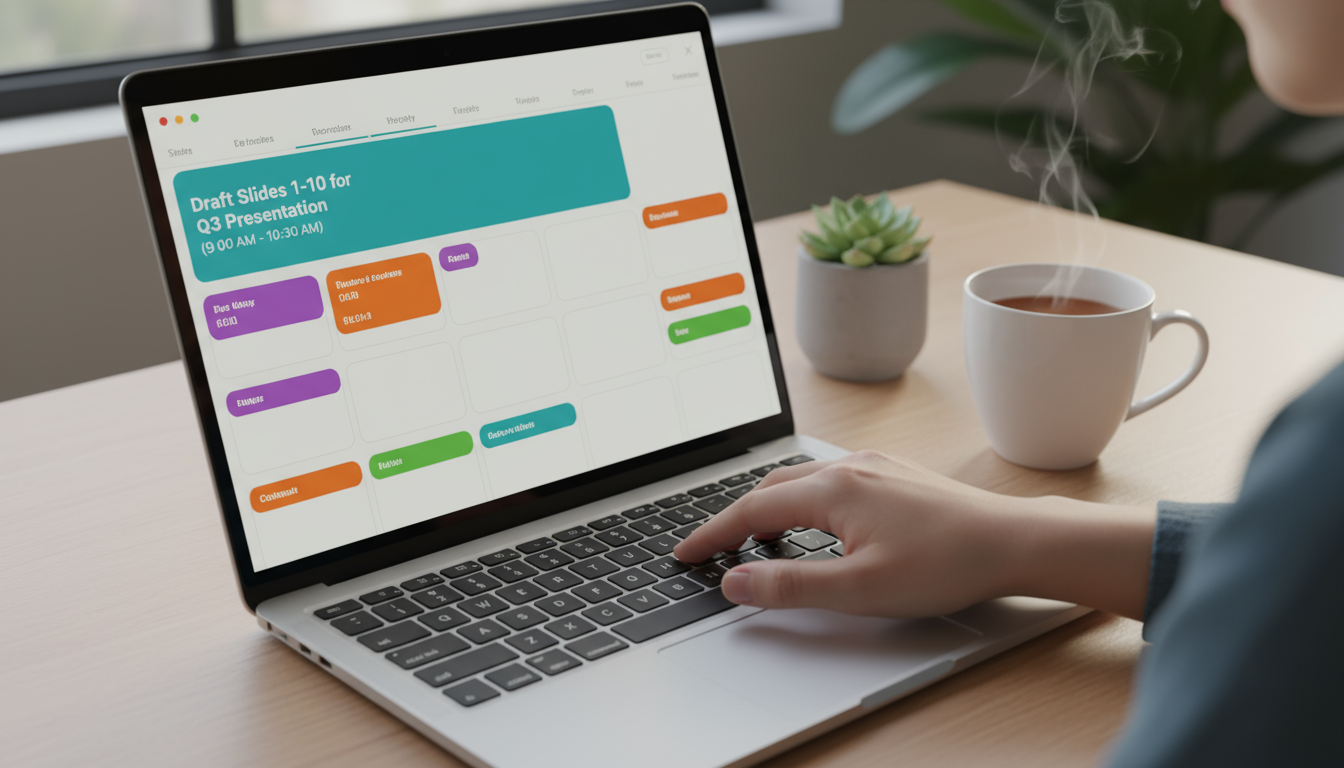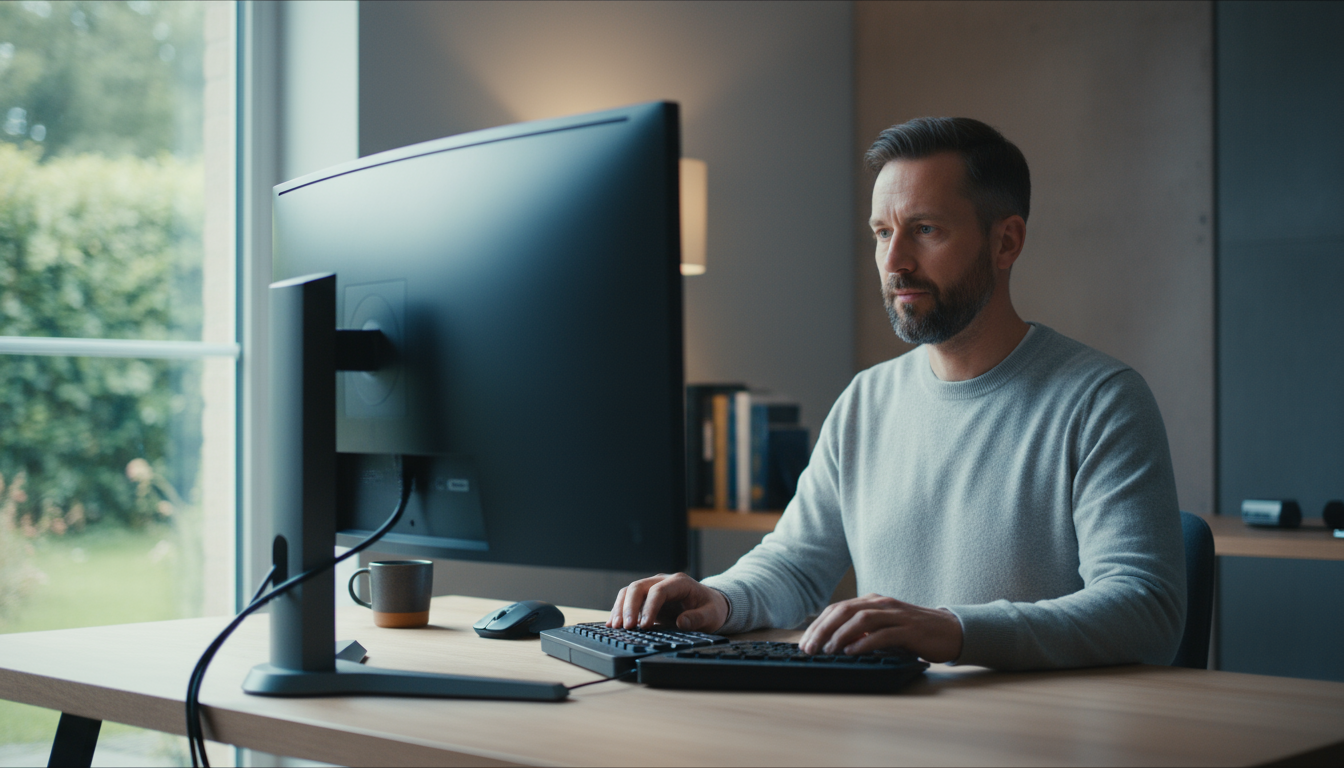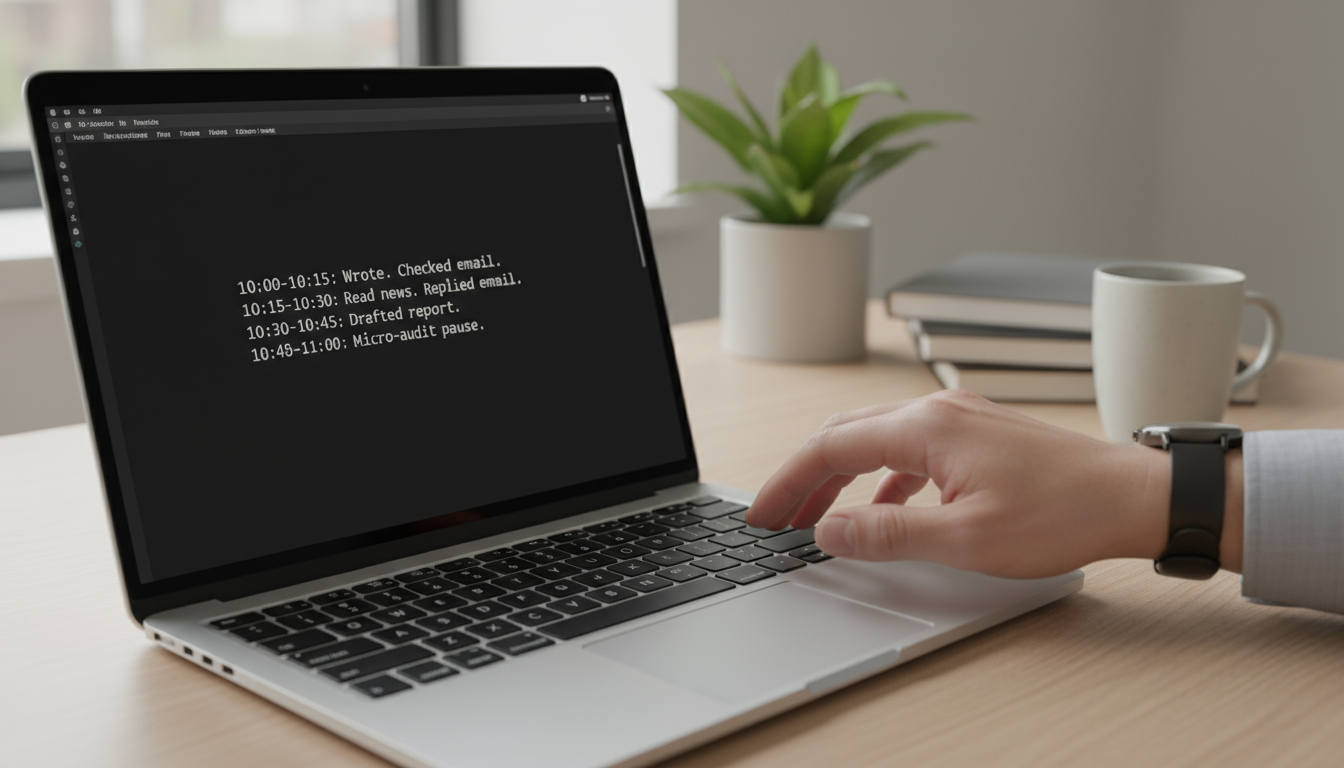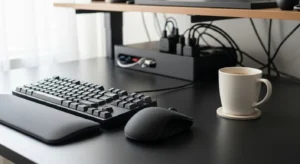
We’ve all been there. The day ends, and you feel utterly exhausted. You were busy, weren’t you? Your mouse clicked a thousand times, you answered a dozen emails, you sat in three meetings, and your Slack notifications were a constant hum. But when you look at your real, meaningful work—the report you needed to write, the strategy you needed to outline—the needle has barely moved.
This is the great illusion of modern work: the equation of busyness with productivity. We glorify the multitasker, the person juggling five things at once, seeing them as a hero of efficiency. But the truth, backed by decades of cognitive science, is that multitasking is a myth. What we are actually doing is rapid, inefficient task-switching, and it’s draining our energy and destroying our focus.
Heroic effort won’t save you. You can’t “willpower” your way through a tsunami of distractions. The most productive and calmest people don’t have more discipline; they have better systems. They build a fortress of focus not with grand gestures, but with small, sustainable habits that make single-tasking the default, not the exception.
This guide is about those systems. It’s not about buying new software or overhauling your entire life. It’s about implementing simple, low-friction hacks that reclaim your attention, one focused block at a time. We’ll explore how to single-task effectively by changing your environment and your approach, proving that the secret to getting more done is, paradoxically, to do less at once.
📚 Table of Contents
- The Power of One: Understanding True Single-Tasking
- Building Your Fortress of Focus: Four Low-Friction Hacks
- Hack 1: The One-Screen Phone
- Hack 2: The 10-Minute Desk Reset
- Hack 3: The 15-Minute Weekly Review
- Hack 4: The Micro Time Audit
- Your Single-Tasking Toolkit: Simple Tools, Powerful Results
- The Calendar as a Shield and a Sword
- The Humble Timer as Your Focus Coach
- Keyboard Shortcuts for Unbroken Flow
- Compounding Habits: From Single Hacks to a Focused System
- Single-Tasking in the Real World: Two Scenarios
- Scenario 1: The Busy Manager
- Scenario 2: The Solo Creator
- Frequently Asked Questions About Single-Tasking
- Your First Step to Ultimate Focus: Start Today

The Power of One: Understanding True Single-Tasking
Before we can master it, we must define it. Single-tasking is the practice of dedicating your full cognitive attention to one, and only one, pre-selected task for a specific period. It is a deliberate, conscious act of mono-focus in a world that screams for multi-focus.
This stands in stark contrast to its deceptive cousin, multitasking. When you think you’re writing an email while listening to a conference call, your brain isn’t doing both simultaneously. Instead, it’s switching back and forth with incredible speed. It’s like a frantic plate-spinner, dashing from one wobbling plate to the next, never giving any single one the stable, continuous spin it needs to stay balanced.
Every time your brain makes one of these switches, it pays a tax. This is known as the “switching cost.” It’s a tiny cognitive penalty in time and mental energy that you pay to disengage from Task A and load the entire context for Task B. A single switch might seem insignificant, but over a day, these costs add up. Research from institutions like the American Psychological Association has shown that these constant interruptions can slash your overall productivity by as much as 40 percent. You’re not just losing the seconds it takes to switch; you’re losing the momentum and depth of thought you had built up.
Worse yet is the phenomenon of “attention residue.” After you switch from checking your email (Task A) to writing that report (Task B), a part of your brain is still thinking about the email. Did I sound too harsh? What will my boss think of that reply? This mental leftover, or residue, clogs your working memory and degrades the quality of your focus on the new task. You’re trying to write a brilliant sentence, but 15% of your brain is still in your inbox.
The single tasking benefits emerge when you eliminate these costs. By committing to one task, you allow your brain to dive deep. Your thoughts become clearer. You enter a state of “flow,” where work feels effortless and time seems to melt away. The quality of the output skyrockets. You produce better work, faster. And because you aren’t forcing your brain through a series of cognitive gymnastics, you end the day with more mental energy, feeling accomplished instead of just busy.

Building Your Fortress of Focus: Four Low-Friction Hacks
Knowing the benefits of single-tasking is one thing; practicing it is another. The key is to create an environment where focus is the path of least resistance. These four hacks require minimal effort to implement but have an outsized impact on your ability to concentrate.

Hack 1: The One-Screen Phone
Your smartphone is the greatest distraction machine ever invented. Its home screen is a buffet of shiny, dopamine-releasing icons, each one begging for a tap. The goal here is to introduce intentional friction.
Here is the exact process: take every single application on your home screen—social media, news, email, games—and drag them into a single folder. Now, move that folder to your second screen. Your primary home screen should be left with only “utility” apps, the ones you use as tools, not as time sinks. This might include your Phone, Messages, Camera, and Calendar. That’s it.
Why does this work? It shatters the mindless loop. When you unlock your phone out of habit, your thumb will find nothing to twitch towards. To open Instagram or check your email, you now have to perform a series of deliberate actions: swipe to the next screen, open the folder, and find the app. This tiny moment of friction is often enough to make you pause and ask, “Do I really need to do this right now?” It transforms your phone from a slot machine into a tool you use with intention.

Hack 2: The 10-Minute Desk Reset
Look at your desk. Is it a calm, inviting workspace, or is it a physical representation of your chaotic to-do list? Piles of paper, old coffee mugs, scattered pens, and sticky notes all act as visual noise. Each item is a tiny, silent interruption, pulling at your focus.
The solution is a simple end-of-day ritual. Set a timer for 10 minutes. In that time, do a full sweep. Put away papers, return books to the shelf, wipe down the surface, and organize your pens. The final, most important step is to set out only what you need for your first and most important task tomorrow. This might be a single notebook and a pen, or just your closed laptop. You are curating your environment for future success.
When you arrive at your desk the next morning, you are not greeted by yesterday’s clutter and a dozen micro-decisions. You are greeted by a clean slate and a clear starting point. This simple act removes visual distraction and signals to your brain: this is what we are focusing on now.

Hack 3: The 15-Minute Weekly Review
Focus is not just about what you are doing in the moment; it’s about ensuring you are working on the right things in the first place. Without a compass, you can row with perfect single-tasking form and still end up in the wrong place. The weekly review is your compass.
Block out 15-20 minutes on your calendar every Friday afternoon. During this time, ask yourself three simple questions. First, look back at your past week: What went well? What were the big wins? Second, what didn’t go as planned? Where were the bottlenecks or frustrations? Third, and most crucially, look ahead to next week: What are the one to three most important things I need to accomplish to make it a success? These become your North Stars.
This isn’t about creating a rigid, hour-by-hour plan. It’s a high-level strategic pause. It ensures that when you sit down on Monday morning to do your focused, single-tasking work, you are directing that powerful beam of attention at a target that truly matters.

Hack 4: The Micro Time Audit
We are often terrible judges of where our time actually goes. We think we spent an hour writing, but in reality, it was 40 minutes of writing interrupted by 20 minutes of “quick” checks of email, news, and social media. A Time Audit is the practice of tracking your activity to get an honest picture of your day.
A full-scale audit can feel daunting, so start small. For just one hour of your next workday, perform a micro-audit. Open a blank notepad or text file. Every 15 minutes, write down exactly what you did in the previous 15-minute block. Be brutally honest.
The results are almost always shocking. You will see the hidden cost of context switching in black and white. “Wrote two sentences of report.” “Checked email, replied to one.” “Read a news headline.” “Re-read the two sentences of the report to remember where I was.” This awareness is the essential first step. You cannot fix a problem you don’t know you have. This single hour of data will give you all the motivation you need to start building your fortress of focus.

Your Single-Tasking Toolkit: Simple Tools, Powerful Results
The best productivity systems don’t require you to learn complex new software. They leverage the simple tools you already have, transforming them from passive organizers into active shields for your attention. Here’s how to sharpen your existing toolkit for maximum focus.

The Calendar as a Shield and a Sword
Most people use their calendar as a passive record of meetings with other people. To master single-tasking, you must start treating appointments with yourself with the same level of respect. This technique is called Timeboxing.
Timeboxing is the act of allocating a fixed, finite period—a “box” of time—to a single task. Instead of a vague to-do list item like “Work on presentation,” you create a calendar event from 9:00 AM to 10:30 AM titled “Draft Slides 1-10 for Q3 Presentation.”
This does several powerful things. First, it makes your day finite. You can see clearly that you only have a few “boxes” available for deep work. Second, it forces you to be realistic about how long tasks will take. Third, it creates a powerful commitment device. When that 9:00 AM calendar reminder pops up, it’s not a suggestion; it’s an appointment. You defend this time as fiercely as you would a meeting with your CEO. Decline incoming requests. Snooze your notifications. For these 90 minutes, your only job is to work on those slides.

The Humble Timer as Your Focus Coach
A timer is one of the most powerful psychological tools for single-tasking. It creates a container for your focus. The most famous application of this is the Pomodoro Technique, which typically involves setting a timer for 25 minutes of focused work, followed by a 5-minute break.
The magic isn’t in the specific interval, but in the binary commitment it creates. When the timer is running, you are working. You are not checking your phone. You are not opening a new tab to “research” something. You are doing the one task you set out to do. If a distracting thought arises, you jot it down on a piece of paper to deal with later and immediately return to the task.
You can use the timer on your phone (put it on Do Not Disturb), a kitchen timer, or a simple web app. The physical act of starting the timer is a ritual that signals to your brain that it’s time to engage. It’s a small, enforceable promise to yourself: for just the next 25 minutes, I will give this my all.

Keyboard Shortcuts for Unbroken Flow
Every time you lift your hand from your keyboard to grab your mouse, you create a micro-interruption. You have to find the cursor, navigate to a menu, and click. While it seems trivial, these tiny breaks in momentum add up, pulling you out of a state of deep concentration.
Becoming a master of single-tasking means smoothing out these small points of friction. You don’t need to learn hundreds of shortcuts. Start by identifying just two or three repetitive, mouse-driven actions you perform every day. Is it creating a new email? Opening a specific project folder? Archiving a message?
Take five minutes to learn the native keyboard shortcut for that action, or create your own. On a Mac, you can go to System Settings > Keyboard > Shortcuts. On Windows, you can often right-click an application or file to create a desktop shortcut and assign a key combination in its properties. The goal is to keep your hands on the keyboard and your mind on the task. It’s not about saving seconds; it’s about preserving the fragile state of flow that is so critical to high-quality work.

Compounding Habits: From Single Hacks to a Focused System
The true power of these techniques is revealed when they start working together. Like small streams flowing into a river, these micro-habits compound over time to create an unstoppable current of focus. A single hack can help you for an hour; a system of interconnected habits can transform your entire working life.
Imagine this chain of events: Your 15-Minute Weekly Review on Friday identified that “Finalizing the project budget” is your most important task for next week. On Monday morning, you arrive at your desk, which is perfectly clear thanks to your 10-Minute Desk Reset ritual from the night before. There are no distractions.
You open your calendar and see the Timebox you created: “9:00 AM – 11:00 AM: Finalize Project Budget.” Your phone is in another room, a direct result of your One-Screen Phone philosophy. At 9:00 AM sharp, you set a physical Timer for 45 minutes, open the spreadsheet, and begin. You work with uninterrupted, deep focus. You are single-tasking not because of immense willpower, but because you have built a system where focus is the easiest and most natural option.
As you get comfortable, you can weave in more advanced techniques. One of the most effective is Batching. This is the practice of grouping similar small tasks together and executing them in one dedicated block. Instead of answering emails as they arrive, creating constant interruptions, you create two “email batch” timeboxes per day, perhaps at 11:30 AM and 4:00 PM. Outside of those times, your email is closed. This transforms you from being reactive to being in control.
Another helpful framework is the 1-3-5 Rule for daily planning. At the start of each day, decide on the 1 big thing, 3 medium things, and 5 small things you want to accomplish. This simple act of prioritization gives your day a clear structure and helps you decide what to single-task on at any given moment.
However, a crucial word of warning: beware of over-optimization. The goal is not to create a perfectly rigid, color-coded schedule that shatters the moment an unexpected meeting appears. The goal is to build a resilient framework that guides your attention. Your system should serve you, not the other way around. If a hack starts causing more stress than it relieves, it’s not the right tool for you. The ultimate aim is sustainable productivity, not a life lived by a stopwatch.

Single-Tasking in the Real World: Two Scenarios
Theory is one thing, but application is everything. Let’s see how these single-tasking principles can be adapted to two very different, and very common, work scenarios.

Scenario 1: The Busy Manager
The Challenge: Maria is a department head. Her days are a chaotic whirlwind of back-to-back meetings, a relentless stream of Slack messages from her team, and a pile of reports that need her review and approval. She feels like a human router, directing traffic but never getting a chance to do her own deep, strategic thinking. She ends every day exhausted but feels like she accomplished nothing truly substantive.
The Single-Tasking Solution:
Maria can’t eliminate meetings or her team’s need for her, but she can control the “in-between” moments.
- Aggressive Timeboxing: She audits her calendar and realizes she has small, 30- to 60-minute gaps between meetings. She starts “timeboxing” these into non-negotiable “Focus Blocks.” She even adds a 15-minute buffer before and after major meetings to process and prepare, preventing one meeting from bleeding into the next.
- Communication Batching: She can’t ignore Slack, but she can tame it. She sets “office hours” and communicates them to her team: “I will be doing a full review of messages and responding from 11:00-11:30 AM and 4:00-4:30 PM. If anything is a true emergency, please call me.” This manages expectations and gives her permission to close Slack during her Focus Blocks.
- The 1-3-5 Rule for Triage: At the start of her day, Maria uses the 1-3-5 rule. Her “1 big thing” is always a task requiring deep thought, which she schedules in her longest Focus Block. The “3 medium things” might be reviewing specific reports, and the “5 small things” are quick replies she can handle during her batched communication time.
By implementing these systems, Maria is no longer just reacting. She has created protected sanctuaries in her day for proactive, focused work, transforming her from a router into a strategic leader.

Scenario 2: The Solo Creator
The Challenge: David is a freelance writer and web developer. His challenge is the opposite of Maria’s: a wide-open, unstructured day. The lack of external deadlines and meetings makes it dangerously easy to fall down “research” rabbit holes, get distracted by social media, or spend hours perfecting a minor detail while neglecting the main project. He struggles with a lack of momentum.
The Single-Tasking Solution:
For David, the key is to create structure and commitment where none exists.
- Theme Days and Timeboxing: David structures his week with themes. Monday and Wednesday are “Writing Days,” Tuesday and Thursday are “Development Days,” and Friday is for admin and planning. Within those days, he timeboxes his work into 90-minute “Deep Work” sessions with a 30-minute break in between.
- Physical Environment Control: He employs the one-screen phone hack religiously. During his 90-minute Deep Work blocks, his phone is not just on silent; it’s in another room. He uses a physical kitchen timer on his desk, so he doesn’t even need to touch his phone to manage his sessions.
- The 10-Minute Desk Reset as a Ritual: At the end of a “Writing Day,” his desk reset involves closing all documents, putting away his research books, and placing his coding keyboard front and center. This ritual primes him for the next day’s context switch, making it easier to jump into development work on Tuesday morning.
David’s system provides the external structure his work lacks. The timer becomes his boss, the timebox his deadline, and the desk reset his commute, allowing him to transition cleanly between different modes of creative work.
Frequently Asked Questions About Single-Tasking
Isn’t this just about discipline? Do I really need new tools or habits?
That’s a common misconception. While discipline is helpful, relying on it alone is like trying to swim against a strong current. You might make progress for a while, but eventually, you’ll tire out. Good habits and systems are about changing the direction of the current. By creating an environment with less distraction (like the one-screen phone) and clear intentions (like timeboxing), you reduce the amount of willpower needed to stay on task. The system does the heavy lifting, preserving your finite discipline for when you truly need it.
I work in customer support and I have to be responsive. How can I single-task?
Single-tasking doesn’t mean becoming unresponsive for eight hours a day. It’s about being intentional. In a role like yours, you can single-task on being responsive. Create “Responsiveness Blocks” where your entire focus is on answering tickets or calls with high quality and no other distractions. Then, you can have separate, shorter “Admin Blocks” where you single-task on updating records or internal follow-ups. The key is to avoid doing both at the exact same time. By focusing fully on the customer in one moment and fully on the admin in the next, the quality of both tasks will improve.
What exactly is the “switching cost” I hear about? Is it real?
It is absolutely real and has been well-documented in cognitive psychology. The switching cost is the measurable disruption in performance that occurs when our brains shift from one set of rules or goals to another. Think of your brain’s working memory like a computer’s RAM. When you switch tasks, you have to “unload” all the data from the first task and “load” all the new data for the second. This process isn’t instant and it isn’t perfect. As noted by leading research bodies like the American Psychological Association, this mental tax can consume a significant portion of your productive time and lead to more errors.
How do I know when to quit a productivity hack that isn’t working for me?
A great question. The rule of thumb is to give any new habit a fair trial, typically one to two weeks, to get past the initial awkwardness. After that period, evaluate it honestly. Is it reducing friction or adding it? Does it make you feel more in control or more anxious? If a hack requires constant, stressful maintenance or doesn’t fit your natural workflow, it’s not the right hack for you. The goal is to find a system that feels sustainable and supportive, not one that feels like a punishment. Productivity is personal; feel free to experiment and discard what doesn’t serve you.
Can single-tasking help with feeling overwhelmed and burnt out?
It can be a powerful antidote. A major contributor to burnout is the feeling of being perpetually busy but making no meaningful progress—spinning your wheels. Multitasking fuels this feeling. Single-tasking does the opposite. By focusing on one task until completion, you generate a series of small wins throughout the day. This sense of accomplishment and forward momentum is incredibly motivating and directly counters the feeling of being overwhelmed. It restores a sense of agency and control, which is critical for mental well-being and preventing burnout. For more on wellness, resources like the National Institutes of Health or the Sleep Foundation provide valuable information.

Your First Step to Ultimate Focus: Start Today
The journey to becoming a master of single-tasking doesn’t start with a massive, life-altering change. It starts with a single, intentional choice, followed by another. It’s not a destination you arrive at, but a skill you cultivate daily. The good news is that the feedback is immediate. The first time you finish a 25-minute focus session, you will feel the clarity and accomplishment that has been missing from your chaotic, multitasking days.
You have the knowledge. The key now is to translate it into action. Don’t try to implement everything at once. Pick one thing and start today. Build momentum, and let these small wins compound into a truly focused and productive life.
Here are four simple actions you can take right now, tonight, and tomorrow to begin building your fortress of focus:
1. Right Now: Tame Your Phone. Take three minutes to implement the one-screen phone hack. Drag all non-utility apps into a single folder on your second screen. Experience the immediate peace of a minimalist home screen.
2. Tonight: Perform the Desk Reset. Before you finish your workday, set a timer for 10 minutes. Clear your workspace completely. Set out only what you need for your most important task tomorrow. Give your future self the gift of a clean slate.
3. Tomorrow Morning: Commit to One Block. Identify your single most important task for the day. Before you do anything else—before you check email—set a timer for just 25 minutes and work on only that task. No interruptions. Just one focused block.
4. This Friday: Schedule Your Compass. Open your calendar right now and block 15 minutes for this coming Friday afternoon. Title the event “Weekly Review.” This is your first step toward working proactively instead of reactively.
Remember, the goal is progress, not perfection. Every focused block is a victory. Every distraction you consciously ignore is a muscle being built. Start small, be consistent, and reclaim the power of your attention.
Disclaimer: The information provided in this article is for informational purposes only and does not constitute professional, medical, or legal advice. Always consult with a qualified professional for advice tailored to your specific situation.






